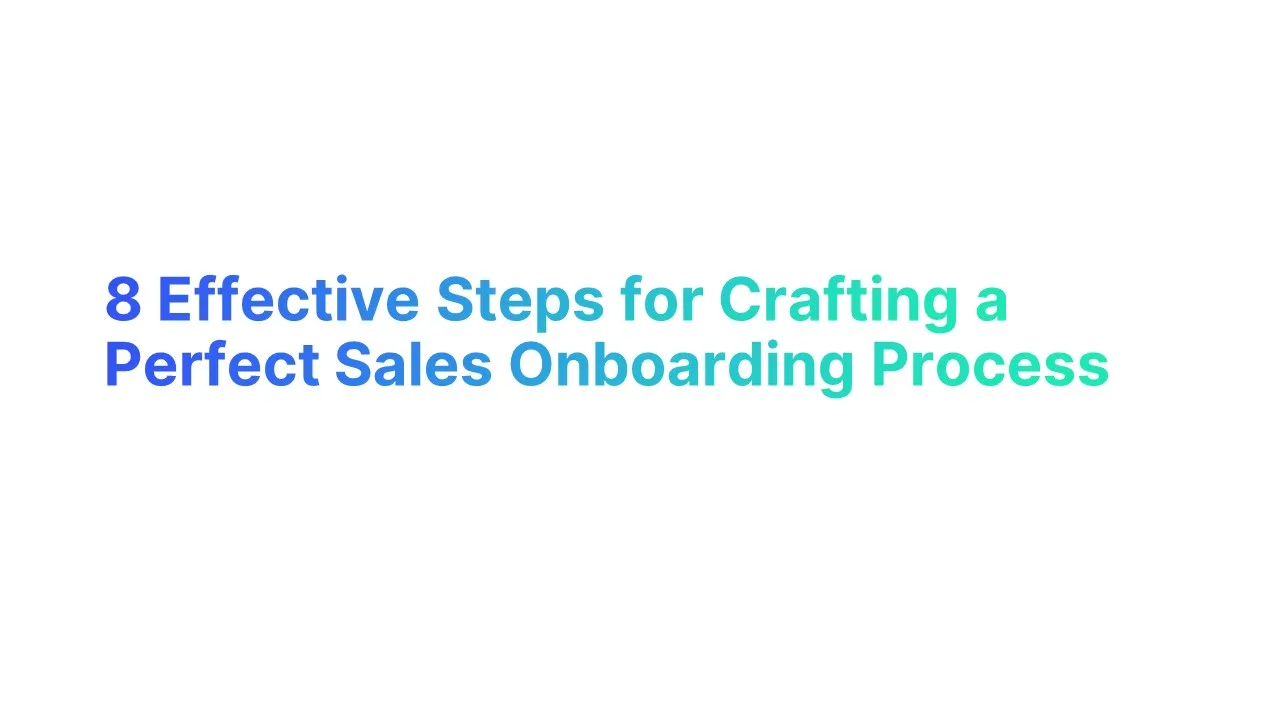Introduction to Sales Onboarding

Sales onboarding is a critical process that ensures new sales reps are fully prepared to succeed in their roles.
Understanding the benefits of sales onboarding is crucial for implementing a planned, high-quality process that maximizes these advantages.
The sales onboarding process includes training and equipping new hires with the necessary skills, knowledge, and tools to become effective members of the sales team.
This process is essential for improving employee engagement, reducing turnover, and increasing sales performance.
According to a study by the Sales Management Association, companies with an effective sales onboarding process see a 60% increase in new hire productivity and a 50% increase in employee retention.
What is Sales Onboarding Process?

The sales onboarding process is a structured approach to integrating new sales hires into the company and preparing them for their roles.
An effective sales onboarding program involves several key steps and best practices to ensure a smooth transition and rapid productivity.
Benefits of a Structured Sales Onboarding Process For Sales Team
A structured sales onboarding process is crucial for ensuring the success of new sales reps.
Implementing a well-defined sales onboarding checklist and process offers numerous benefits for the sales team and the organization as a whole. Here are some key advantages:
1. Faster Ramp-Up
A structured sales onboarding program accelerates the ramp-up time for new sales reps.
By providing comprehensive training and clear guidelines, new hires can quickly become productive members of the sales team.
- Effective Training Programs: Sales onboarding includes training on product knowledge, sales techniques, and company culture, which helps new sales reps understand their role and how to succeed.
- Hands-On Experience: Pairing new sales reps with experienced sales reps for shadowing and mentorship accelerates learning and builds confidence.
2. Higher Retention Rates
A well-structured sales onboarding process leads to higher retention rates among new hires.
When new sales reps feel supported and valued, they are more likely to stay with the company long-term.
- Employee Engagement: Engaging onboarding processes foster a sense of belonging and commitment to the company's mission and goals.
- Reduced Turnover Costs: High retention rates reduce the costs associated with recruiting and training new sales hires.
3. Consistent Training
Consistency in training ensures that all sales reps receive the same high-quality education, which is crucial for maintaining a unified and effective sales team.
- Standardized Programs: Structured onboarding programs ensure that all new sales reps receive the same information and training.
- Best Practices: Consistent training incorporates best practices that are proven to be effective, leading to better overall performance.
4. Enhanced Confidence
A thorough and comprehensive onboarding program and process boosts the confidence of new sales reps, enabling them to approach their roles with assurance and competence.
- Regular Feedback: Providing new sales reps with regular feedback from sales managers helps them understand their progress and areas for improvement.
- Supportive Environment: A supportive onboarding environment where new hires can ask questions and seek guidance builds their confidence.
5. Improved Performance
Ultimately, a structured sales onboarding process leads to improved performance across the sales team.
Well-prepared sales reps are more effective in their roles, leading to better sales outcomes.
- Higher Sales Targets: Studies show that companies with comprehensive onboarding programs achieve 60% higher sales goal attainment.
- Performance Metrics: Effective onboarding includes measuring sales performance and readiness, ensuring that new sales reps are meeting their targets.
Steps for Sales Onboarding Process of New Sales Reps

A well-structured sales onboarding process is essential for preparing a new sales rep to succeed in their role.
Here are the key steps involved in the successful sales onboarding process:
STEP 1: Pre-Onboarding Preparation
The pre-onboarding phase involves getting everything ready before the new sales reps start their first day.
This sets the stage for a smooth and effective onboarding program and process.
- Documentation and Access: Ensure all necessary paperwork is completed, and new hires have access to essential systems and tools.
- Welcome Package: Send a welcome package that includes company information, product literature, and a detailed sales onboarding plan.
- Internal Communication: Inform the sales team about the new hires, including their roles and start dates.
STEP 2: Orientation and Introduction
Orientation is the first official step of the sales onboarding process.
It introduces new sales reps to the company and their new team members.
- Company Overview: Provide an introduction to the company's mission, vision, and values. This helps new sales reps understand the company's culture and goals.
- Meet the Team: Arrange meetings with key team members, including sales managers and sales leaders, to build relationships and foster collaboration.
- Role Expectations: Clearly outline the responsibilities and expectations for the new sales reps. This includes discussing sales targets, performance metrics, and key skills required.
STEP 3: Product and Process Training
Training on products and processes is a critical part of the new sales professionals' onboarding process.
This ensures new sales reps have the knowledge they need to sell effectively.
- Product Knowledge: Comprehensive training on the company's products, including features, benefits, and competitive advantages.
- Sales Process: Detailed instruction on the sales process, including lead generation, sales funnel management, and closing techniques.
- Sales Tools: Training on the sales tools and software used by the company, such as CRM systems and sales enablement platforms.
STEP 4: Skill Development and Practice
Developing and practicing essential sales skills is crucial for new top sales professionals and reps.
This step focuses on hands-on training and real-world application.
- Role-Playing Exercises: Conduct role-playing exercises to simulate sales scenarios and practice selling skills.
- Shadowing Experienced Sales Reps: Allow new sales reps to shadow experienced sales reps to learn best practices and observe successful techniques.
- Ongoing Feedback: Provide regular feedback from sales managers and experienced team members to help new sales reps improve and refine their skills.
STEP 5: Initial Practice and Feedback
Initial practice and feedback are crucial for new sales reps to apply their training in real-world scenarios.
This phase helps bridge the gap between theoretical knowledge and practical application.
- Pilot Sales Calls: New sales reps make their first sales calls under supervision, allowing them to put their training into practice.
- Constructive Feedback: Sales managers provide detailed feedback on these initial calls, highlighting strengths and areas for improvement.
- Adjust and Adapt: Based on feedback, new sales reps can adjust their approach and techniques to enhance their performance, ensuring continuous improvement.
Research shows that structured feedback can improve sales rep performance by 20%, highlighting the importance of this step in the sales onboarding process.
STEP 6: Active Selling and Feedback
As new sales reps transition to active selling, ongoing feedback remains essential.
This step focuses new reps on real-world selling activities with regular performance reviews.
- Active Selling: New sales reps engage in regular sales activities, applying their training to actual sales scenarios.
- Regular Check-Ins: Sales managers hold regular check-ins to discuss progress, challenges, and strategies for improvement.
- Performance Metrics: Monitoring key performance metrics, such as sales targets and conversion rates, helps in assessing the effectiveness of the sales onboarding process.
According to the Sales Management Association, continuous feedback can lead to a 15% increase in sales productivity, making it a vital component of the great sales onboarding program and process.
STEP 7: Performance Benchmarking and Skill Refinement
Benchmarking performance and refining skills are essential for the ongoing development of new sales reps.
This step ensures that new hires are on par with their peers and continuously improving.
- Benchmarking Against Peers: Compare new sales reps' performance with that of their peers to identify areas for improvement.
- Skill Refinement: Provide targeted training sessions to address specific weaknesses and enhance strengths, ensuring continuous skill development.
- Sales Goal Attainment: Ensure new sales reps are meeting or exceeding their sales targets through continuous skill refinement and development.
Studies indicate that companies with performance benchmarking processes see a 30% increase in overall sales performance, underscoring the importance of this step in the sales onboarding program.
STEP 8: Continuous Support and Development
The final step in the sales onboarding process is providing continuous support and development to new sales reps.
This ongoing phase of sales cycle ensures that sales reps remain engaged and productive long after their initial onboarding.
- Mentorship Programs: Establish long-term mentorship programs where experienced sales reps guide new hires, providing ongoing support and advice.
- Advanced Training: Offer advanced training programs and workshops to keep sales reps up-to-date with the latest sales techniques and tools.
- Career Development: Support career development by providing opportunities for advancement within the sales team, fostering a culture of continuous improvement and growth.
Effective continuous support and development can lead to a 24% increase in employee retention rates, as per a report by Gallup.
Three Phases of Sales Onboarding Process For New Sales Reps

The onboarding process can be divided into three key phases:
Initial Orientation and Integration, Skill Development and Practice, and Performance and Autonomy.
PHASE 1: Initial Orientation and Integration
The first phase of the new sales and new rep onboarding process focuses on welcoming new sales reps and providing them with the foundational knowledge they need to start their journey with the company.
- Company Overview: New sales reps are introduced to the company's mission, vision, and values. This helps them understand the company's culture and how they fit into the larger goals.
- Meet the Team: Arranging introductions with key members of the sales team, including sales managers and sales leaders, fosters a sense of belonging and collaboration.
- Role Expectations: Clearly outlining the responsibilities, sales targets, and performance metrics for new sales reps sets clear expectations from the start.
Research shows that effective orientation programs can improve employee retention rates by up to 25%, highlighting the importance of this initial phase.
PHASE 2: Skill Development and Practice
The second phase involves equipping new sales reps with the necessary skills and knowledge through hands-on practice and continuous feedback.
- Comprehensive Training: Provide training on product knowledge, sales techniques, and the sales process to ensure new hires are well-prepared.
- Role-Playing and Simulations: Conduct role-playing exercises to help new sales reps practice and refine their selling skills.
- Regular Feedback: Sales managers offer continuous feedback to guide new hires and help them improve.
According to the Sales Management Association, companies with structured training programs see a 50% increase in new hire productivity.
PHASE 3: Performance and Autonomy
The final phase aims to measure sales readiness and transition new sales reps to independent, high-performing members of the sales team.
- Active Selling: Allow new sales reps to engage in real-world selling activities with minimal supervision.
- Performance Benchmarking: Compare new sales reps’ performance against peers to identify areas for improvement.
- Continuous Support: Provide ongoing support and development opportunities, such as mentorship programs and advanced training.
Effective onboarding programs can reduce time to productivity by 34%, underscoring the importance of this phase in ensuring long-term success.
Goals of Sales Onboarding Process

The sales onboarding process is designed to equip new sales reps with the tools, knowledge, and confidence they need to excel.
Here are the primary goals of an effective sales onboarding process:
1. Knowledge Transfer
Transferring critical knowledge is essential to ensure new sales reps understand the company’s products, services, and target market.
- Product Knowledge: New hires must gain a deep understanding of the products they will be selling, including features, benefits, and competitive advantages.
- Sales Process: Training on the company’s sales process, including lead generation, pipeline management, and closing techniques, is crucial for consistent performance.
- Company Information: Knowledge about the company’s mission, vision, values, and culture helps new sales reps align with the organization's goals.
2. Skill Development
Developing the necessary skills is vital for new sales reps to perform their roles effectively.
- Sales Techniques: Comprehensive training on various sales techniques, such as consultative selling and objection handling, prepares new hires for real-world scenarios.
- Communication Skills: Enhancing verbal and written communication skills ensures new sales reps can effectively engage with potential customers.
- Technology Proficiency: Familiarity with sales tools and software, such as CRM systems and sales enablement platforms, is critical for efficiency and effectiveness.
Companies with structured skill development programs see a 36% increase in sales rep performance.
3. Role Clarity
Clear understanding of their roles helps new sales reps know what is expected of them by sales organizations and how to achieve success.
- Job Expectations: Detailed explanations of job responsibilities, sales targets, and performance metrics ensure new hires know what is required.
- Performance Benchmarks: Setting clear performance benchmarks helps new sales reps understand how their success will be measured.
- Feedback Mechanisms: Regular feedback from sales managers helps new sales reps stay on track and continuously improve.
Clear role clarity can reduce new hire turnover by up to 20%.
4. Cultural Integration
Integrating new sales reps into the company culture fosters a sense of belonging and commitment.
- Company Culture: Introducing new hires to the company's culture, including its values and norms, helps them feel more connected and engaged.
- Team Integration: Facilitating introductions and interactions with the sales team and other departments builds relationships and promotes collaboration.
- Mentorship Programs: Pairing new sales reps with experienced mentors provides ongoing support and guidance.
Cultural integration engaged employees is linked to a 25% increase in employee engagement and retention.
5. Process Familiarity
Ensuring that new sales reps are familiar with the company’s sales process is crucial for maintaining consistency and efficiency.
- Sales Process: Comprehensive training on the sales process, including lead generation, sales funnel management, and closing techniques, helps new sales reps understand how to navigate their roles effectively.
- Technology and Tools: Familiarity with sales tools, CRM systems, and sales enablement platforms ensures that new hires can leverage technology to streamline their workflows.
- Standard Operating Procedures: Clear guidelines on standard operating procedures help new sales reps adhere to best practices and maintain consistency in their approach.
Research shows that familiarity with processes and tools can improve sales rep performance by up to 40%, underscoring the importance of this goal.
6. Productivity Acceleration
Accelerating the productivity of new sales reps is a primary goal of the first sales manager onboarding process. This involves their essential selling skills and equipping them to achieve their targets swiftly and efficiently.
- Effective Training Programs: Training on product knowledge, sales techniques, and the sales process ensures that new hires are well-prepared to start selling quickly.
- Support and Resources: Providing ongoing support and access to resources helps new sales reps overcome challenges and improve their performance.
- Clear Expectations: Setting clear expectations and goals from the beginning enables new hires to focus on achieving their targets.
Studies indicate that effective sales onboarding best practices can reduce time to productivity by 34%, making it a critical objective for any sales team.
7. Performance Benchmarking
Benchmarking performance helps new sales reps understand how they measure up against their peers and identify areas for improvement.
- Key Performance Metrics: Establishing clear performance metrics, such as sales targets and conversion rates, allows new sales reps to gauge their success.
- Regular Evaluations: Conducting regular performance evaluations helps identify strengths and areas for development.
- Feedback Mechanisms: Providing constructive feedback from sales managers and experienced team members ensures continuous improvement and alignment with sales goals.
Companies that implement performance benchmarking as part of their sales onboarding process see a 20% increase in overall sales performance.
8. Customer Understanding
A deep understanding of the customer is crucial for effective selling. The entire sales department onboarding process must focus on equipping new sales reps with this knowledge.
- Buyer Personas: Training on buyer personas helps new sales reps understand the needs, behaviors, and pain points of their target customers.
- Market Insights: Providing insights into market trends and competitive analysis enables sales reps to position their products effectively.
- Customer Success Stories: Sharing customer success stories illustrates how the company’s products have resolved real-world problems, enhancing the credibility of new sales reps.
According to Salesforce, sales reps who thoroughly understand their customers are 52% more likely to exceed their sales targets.
9. Compliance Adherence
Adherence to compliance and regulatory standards is essential to avoid legal issues and maintain the company’s reputation.
- Regulatory Training: New sales reps must be trained on relevant industry regulations and company policies to ensure compliance.
- Ethical Selling Practices: Emphasizing the importance of ethical selling practices helps maintain trust and integrity in the sales process.
- Regular Audits: Implementing regular compliance audits ensures that new hires adhere to all necessary guidelines and standards.
A study by McKinsey & Company found that companies with robust compliance programs are 22% more likely to achieve high sales performance.
10. Confidence Building
Building confidence in new sales reps is critical for their success and long-term retention.
- Role-Playing Exercises: Conducting role-playing exercises helps new sales reps practice their skills in a safe environment, building confidence.
- Positive Reinforcement: Providing positive feedback and celebrating small wins encourages new hires and boosts their confidence.
- Ongoing Support: Continuous support from sales managers and mentors ensures that new sales reps feel valued and confident in their roles.
A report by Harvard Business Review states that confident sales reps are 35% more likely to close deals effectively.
Key Components of a Sales Onboarding Process

A comprehensive sales onboarding process is essential for ensuring new sales reps are well-equipped to succeed.
Key components include Product Training, Sales Process Training, CRM Tools Training, Mock Sales Calls, and Performance Metrics.
1. Product Training
Understanding the products they will sell is crucial for new sales reps.
Product training ensures they are knowledgeable about features, benefits, and competitive advantages.
- In-Depth Knowledge: New sales reps must learn the ins and outs of the product to confidently address customer questions and objections.
- Practical Application: Training should include real-world scenarios where reps can see the product in action.
- Ongoing Updates: Regular updates on product changes and new features keep sales reps informed and effective.
2. Sales Process Training
Equipping new sales reps with a clear understanding of the sales process ensures consistency and efficiency in sales department.
- Step-by-Step Guide: Detailed instruction on each stage of the sales process, from lead generation to closing deals.
- Sales Techniques: Training on various sales techniques, such as consultative selling and objection handling.
- Process Integration: Ensuring new hires understand how the sales process integrates with other business functions.
3. CRM Tools Training
Familiarity with CRM tools is essential for managing customer relationships and sales pipelines effectively.
- System Navigation: Training on how to navigate and use the CRM system.
- Data Entry and Management: Best practices for entering and managing customer data.
- Sales Tracking: Using CRM tools to track sales activities and performance metrics.
4. Mock Sales Calls
Practice makes perfect, and mock sales calls are a vital part of the sales onboarding process.
- Simulated Scenarios: Conducting role-playing exercises that mimic real sales situations.
- Feedback Sessions: Providing constructive feedback on performance to help new sales reps improve.
- Confidence Building: Helping new hires gain confidence in their selling abilities through practice.
5. Performance Metrics
Establishing company goals and clear performance metrics helps new sales reps understand their goals and measure their sales success well.
- Key Indicators: Identifying key performance indicators (KPIs) such as conversion rates, sales targets, and customer satisfaction scores.
- Regular Reviews: Conducting regular performance reviews to track progress and provide feedback.
- Continuous Improvement: Using performance data to identify areas for improvement and adjust training accordingly.
Top Sales Onboarding Software Solutions

Implementing the right sales onboarding software can significantly enhance the onboarding process for new sales reps.
Here are some of the top sales onboarding software solutions available today:
1. Lessonly

Lessonly is a popular choice for a sales onboarding platform due to its user-friendly interface and robust features.
- Interactive Training Modules: Lessonly offers interactive modules that help new sales reps quickly grasp product knowledge and sales techniques.
- Performance Metrics: The platform tracks performance metrics to monitor progress and identify areas for improvement.
- Collaborative Learning: Lessonly fosters collaboration among sales team members through shared learning experiences.
According to G2, companies using Lessonly report a 45% improvement in new hire productivity.
2. SalesHood

SalesHood is designed to streamline the sales onboarding process and improve sales rep performance.
- Comprehensive Training Programs: SalesHood provides extensive training programs covering product knowledge, sales process training, and CRM tools training.
- Sales Process Integration: The platform seamlessly integrates with existing sales processes and tools.
- Mock Sales Calls: SalesHood includes features for conducting mock sales calls, allowing new sales reps to practice and receive feedback.
Research indicates that companies using SalesHood see a 30% increase in sales productivity.
3. Brainshark

Brainshark is known for its powerful content creation and training capabilities.
- Dynamic Content Creation: Brainshark enables the creation of engaging training content, including videos and presentations.
- Performance Benchmarking: The platform offers performance benchmarking tools to track the effectiveness of the sales onboarding process.
- On-Demand Training: Sales reps can access training materials on-demand, allowing them to learn at their own pace.
A report by Forrester states that Brainshark users experience a 20% increase in sales performance.
4. MindTickle

MindTickle provides a comprehensive solution for sales onboarding and sales enablement platform continuous learning.
- Gamified Learning: MindTickle incorporates gamification elements to make learning more engaging for new sales reps.
- Sales Enablement Platforms: The software integrates with various sales enablement platforms, enhancing its functionality.
- Continuous Feedback: MindTickle offers continuous feedback mechanisms to help sales reps improve their skills.
Studies show that companies using MindTickle achieve a 25% higher sales target attainment rate.
5. Showpad

Showpad combines sales training with content management and sales enablement tools to provide a holistic sales onboarding training solution.
- Integrated Sales Content: Showpad offers a centralized repository for all sales content, making it easy for new sales reps to find and use resources.
- Interactive Training: The platform features interactive training modules that cover product training, sales process training, and more.
- Performance Metrics: Showpad tracks performance metrics to ensure that new hires are meeting their goals.
According to Salesforce, companies using Showpad report a 35% increase in sales efficiency.
Common Challenges and Solutions in the Sales Onboarding Process
The sales onboarding process is essential for preparing new sales reps for success. However, several common challenges can hinder its effectiveness. Here are some of these challenges and their solutions:
1. Information Overload
New sales reps often face information overload, making it difficult to retain critical knowledge.
- Solution: Break down the sales onboarding process into manageable chunks. Use a phased approach to deliver information gradually.
- Structured Training Programs: Implement structured training programs that prioritize essential information first.
2. Inconsistent Training
Inconsistent training can lead to disparities in performance among new sales reps.
- Solution: Standardize the training process across the organization.
- Unified Training Modules: Develop unified training modules that ensure all new hires receive the same level of training on product knowledge, sales techniques, and CRM tools.
3. Lack of Engagement
A lack of engagement during the onboarding process can result in decreased motivation and retention rates.
- Solution: Incorporate interactive and engaging training methods.
- Gamified Learning: Use gamified learning and role-playing exercises to make training more engaging.
- Mentorship Programs: Implement mentorship programs where experienced sales reps guide new hires.
4. Insufficient Feedback
Without regular feedback, new sales reps may not know how to improve their performance.
- Solution: Establish a system for continuous feedback.
- Regular Check-Ins: Schedule regular check-ins with sales managers to discuss progress and provide constructive feedback.
- Performance Metrics: Use performance metrics to guide feedback and measure improvement.
5. Role Misalignment
Role misalignment can lead to confusion and inefficiency among new sales reps.
- Solution: Clearly define roles and expectations from the beginning.
- Job Descriptions: Provide detailed job descriptions that outline responsibilities and performance metrics.
- Role Clarity Sessions: Conduct role clarity sessions during the onboarding process.
Conclusion
Sales onboarding process is crucial for preparing new sales reps to succeed.
By addressing common challenges such as information overload, inconsistent training, lack of engagement, insufficient feedback, and role misalignment, companies can significantly enhance new hire productivity and knowledge retention.
Implementing standardized training on product knowledge, sales techniques, and CRM tools, along with regular performance metrics and continuous feedback from sales managers, ensures role alignment and reduces new hire turnover.
Ultimately, an effective sales onboarding process leads to engaged new employees throughout, better performance, and a more successful sales team.





.jpg)

.jpg)
